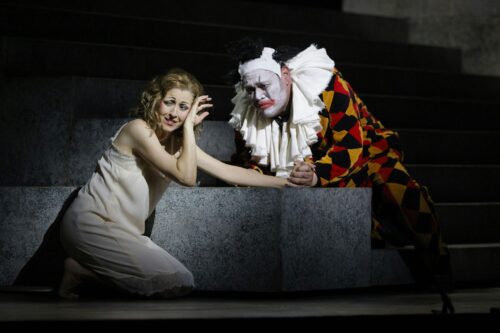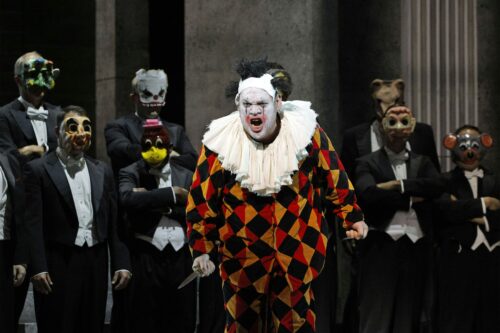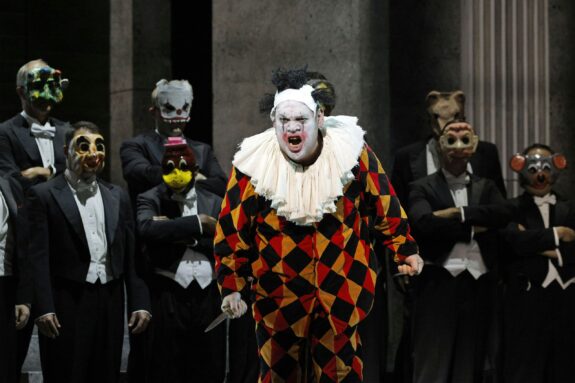 United States Verdi, Rigoletto: Soloists, Chorus and Orchestra of LA Opera / James Conlon (conductor). Dorothy Chandler Pavilion, Los Angeles, 31.5.2025. (JRo)
United States Verdi, Rigoletto: Soloists, Chorus and Orchestra of LA Opera / James Conlon (conductor). Dorothy Chandler Pavilion, Los Angeles, 31.5.2025. (JRo)

Verdi’s Rigoletto abounds in beautiful melodies, heart-wrenching drama and biting social criticism. It is arguably his finest opera. When the singers portraying Rigoletto and Gilda are dramatically and musically secure, the opera is never less than moving. Then, once in a lifetime, a performance arrives that becomes more than a fine night at the opera.
LA Opera’s production with Quinn Kelsey as Rigoletto, Lisette Oropesa as Gilda and James Conlon in the pit will linger in the memory long after other productions fade. This was an extraordinary night of music and drama. Kelsey inhabited the role so completely that I forgot I was in the theatre watching an entertainment: he laid bare Rigoletto’s soul for all to see. His warm, honeyed baritone was rich in power, nuance and color, and his body language, so organic to the hunchbacked jester, weary and beleaguered from his life at court, felt like he wasn’t acting. He moved from surly jester to doting father to a man undone by events with slight adjustments to his bearing that spoke volumes.
Lisette Oropesa, with her beautiful tone, slight frame and believable girlishness was utterly convincing as the innocent daughter, hunted by the Duke of Mantua and his fellow debauchees. From her tender duet with Kelsey in Act I, beginning with Rigoletto’s injunction to the maid (‘Veglia o donna, questo fiore’) to their agonized ‘Piangi fanciulla’ of Act II, Oropesa and Kelsey were deeply attuned to one another. After Gilda was delivered to the Duke for his pleasure and she found her father outside in the hall, they were two shipwrecked souls, but in such true harmony that I felt like a voyeur invading their privacy. Oropesa navigated the transition from innocence to maturity both in her stage presence and voice, moving from lyric coloratura to dramatic soprano which distinguishes her altered state.
René Barbera sang with the gusto befitting his role as the lascivious duke. From his first moment on stage, he was in full voice, opening with the bouncing ‘Questa o quella’ which establishes his sense of imperial entitlement. His glowing, Italianate tenor shone in ‘La donna è mobile’ and in his disconsolate aria of Act II, when he thought Gilda had flown from her house.
From the ominous orchestral prelude that inaugurates Monterone’s curse to the buoyant melodies, tender duets and arias and on to the catastrophic storm and murderous conclusion, Conlon conducted with the surehandedness and artistry we have come to expect from this peerless interpreter of Verdi’s music.
Act III, with its extraordinary quartet and orchestral interpretation of a raging storm through to the unintentional murder of Gilda, was riveting. Every voice in the quartet – Kelsey, Oropesa, Barbera and the compelling Sarah Saturnino as Maddalena – was in balance, creating a raw and frightening portent of events to come.
As Sparafucile, Peixin Chen with his vigorous bass was a convincing assassin, dressed in stripes and suspenders like a character from the seedy underworld of The Threepenny Opera. He had the steely determination to do his job combined with the nonchalance of the truly amoral man. He was particularly chilling in the fierce trio in the midst of the tempest. Also of note were Blake Denson as Count Monterone, whose curse forms the core of the opera and haunts Rigoletto to the bitter end, and Hyungjin Son as the courtier, Marullo.

The Men’s Chorus was a character in itself. Often masked as grotesque animals or with odd human faces, they conjured a pack of wolves, ready to devour at the slightest provocation. They flooded the stage with song and their powerful presence.
The modernist sets by Erhard Rom were evocative of Fascist Italy where the production was set. Amid the tall columns of a Ducal Palace, a Mannerist-style drawing of Dionysius dominated the hall – a fitting image. Jessica Jahn’s costumes depicted the jester as a humpbacked Harlequin and dressed the rest of the cast in attire of the 1920s and 1930s.
Tomer Zvulun’s direction was superb (there was one hitch in the abduction scene, but this was a mere hiccup). In a brilliant stroke, he created a formidable concept for the ending: Rigoletto, upon hearing the far-off singing of the Duke’s ‘La donna è mobile,’ imagined he was still alive after his contracted murder. On his knees in despair, Rigoletto repeatedly stabbed the body in the sack. It was a horrifying action, knowing that Gilda was hidden within. Instead of the traditional ending, with Rigoletto holding a still breathing Gilda in his arms, Oropesa entered in a white slip and moved slowly across the stage – a specter now haunting her father. It was in this guise that she sang her farewell to him, and we were left to mourn her tragic death along with the broken jester.
Jane Rosenberg
Production:
Director – Tomer Zvulun
Sets – Erhard Rom
Costumes – Jessica Jahn
Lighting – Robert Wierzel
Chorus director – Jeremy Frank
Choreographer – Ricardo Aponte
Fight & Intimacy director – Andrew Kenneth Moss
Cast:
Rigoletto – Quinn Kelsey
Gilda – Lisette Oropesa
Duke of Mantua – René Barbera
Count Monterone – Blake Denson
Sparafucile – Peixin Chen
Maddalena – Sarah Saturnino
Marullo – Hyungjin Son
Borsa – Nathan Bowles
Count Ceprano – Vinícius Costa
Giovanna – Madeleine Lyon
Countess Ceprano / Page – Gabrielle Turgeon
